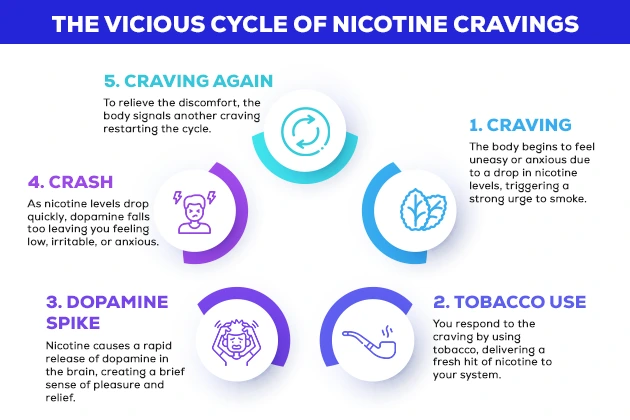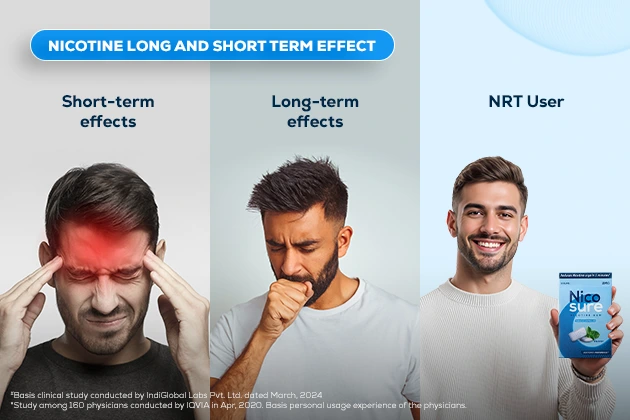Get Up to 50% OFF + Extra 15% OFF. Use Code: DHAMAKA15 | Shop Now !
Get Up to 50% OFF + Extra 15% OFF. Use Code: DHAMAKA15 | Shop Now !
August 12, 2025 0 Comments
Quitting tobacco is often described as one of the most difficult habits to break. That’s because nicotine, the addictive substance found in tobacco, has a powerful impact on the brain. Many people who try to stop using tobacco products experience withdrawal symptoms that make it hard to stay on track. This struggle is a result of nicotine dependence, a condition that affects millions globally.
Understanding the causes of nicotine dependence and knowing the available solutions can help you or someone you love take meaningful steps toward quitting. This guide explains what nicotine addiction looks like, why it happens, and what treatment options exist, including Nicotine Replacement Therapy (NRT) such as nicotine gums or nicotine lozenges for quitting tobacco.
Nicotine dependence is a condition in which a person becomes physically and psychologically reliant on nicotine, a chemical found in tobacco. Over time, regular use of tobacco products changes how the brain functions, causing strong cravings that make quitting feel nearly impossible.
“Nicotine is considered as addictive as heroin and cocaine, due to its effect on the brain's reward system.”
-U.S. Department of Health and Human Services, 2010 Surgeon General’s Report
When someone is dependent on nicotine, they may:
This addiction is not just about habits or routines. It is rooted in brain chemistry and needs more than just willpower to overcome.
The symptoms of nicotine dependence can vary, but some of the most common ones include:
These symptoms can begin within just a few hours of stopping tobacco use, which is why withdrawal can feel overwhelming. To understand how symptoms change over time, read our detailed guide on the Nicotine Withdrawal Timeline.


“Tobacco kills more than 8 million people each year worldwide, including 1.2 million due to second-hand smoke.”
-World Health Organization (WHO), 2023
According to the World Health Organization, tobacco use remains the leading preventable cause of disease and death worldwide.
NRT helps reduce withdrawal symptoms by delivering a controlled amount of nicotine without the harmful chemicals found in tobacco. Common NRT formats include:
- Patches, sprays, and inhalers (often prescribed by healthcare providers)
When used correctly, NRT can double the chances of quitting successfully.
Doctors may prescribe medications such as bupropion (Zyban) or varenicline (Chantix) to reduce cravings and withdrawal symptoms. These medicines target brain receptors that are affected by nicotine.
Counseling or support groups help individuals understand their triggers and build healthier coping mechanisms. This can be done in person, online, or through helplines.
Mobile apps and government-run tobacco cessation programs in India offer quit plans, reminders, motivational content, and tracking tools to help you stay on track.
Recovery from nicotine dependence is not an overnight process, but it is absolutely achievable. Here’s how to begin:
For more strategies, explore our blogs on how to manage tobacco cravings without gaining weight.
Nicotine dependence is a real and challenging condition, but it is not unbeatable. With the right tools, information, and support, you can overcome the urge to use tobacco and reclaim control of your health. Whether you're just starting or restarting your quit journey, you're not alone.
Start small. Stay consistent. And if the cravings come, know that products like nicotine gums for quitting tobacco and nicotine lozenges in India can support you through every step of your recovery. You have the strength to quit, and Nicosure is here to help.
Nicosure Nicotine Gums and Lozenges are designed to reduce withdrawal symptoms, including nicotine cravings associated with quitting smoking, quitting chewed tobacco, and gutkha containing tobacco.